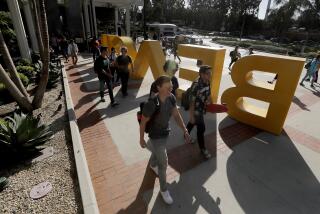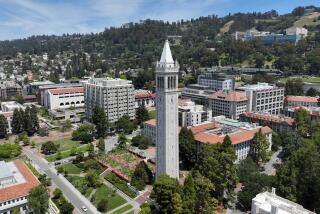On the Cutting Edge : UCI Funding Reductions Leave Students, Faculty Worried
- Share via
IRVINE — The atmosphere seemed festive, even carnival-like at UC Irvine last week as returning students engaged in rope-pulling contests, dunk-the-student-leader ball tosses, and sampled the competing delicacies of Korean barbecue and freshly baked cookies.
Yet even as they joked and caught up with the summer happenings of old friends, the word on nearly everyone’s lips as the fall quarter was set to begin this week was the 24% increase in student fees, cuts in student aid grants and fears that it will take them even longer than the current average of five years to graduate.
“We’re paying more, but we’re getting less,” complained Lopsie Chan, a political science and economics double major from Monterey Park. She is in her fifth year at UCI, in part, she said, because of the difficulty in getting certain required courses.
“The library is opened fewer hours and we’re getting less services,” she said. “It just seems like a gyp.”
Professors were worried too, and some say morale is flagging, as departments scrambled to add required courses such as writing, basic physics and chemistry, and rearranged faculty schedules, in some cases cutting into research time.
“It’s the worst I’ve ever seen in 25 years at UCI,” said Harold Moore, dean of the School of Physical Sciences, who for the first time in recent memory does not have enough money in his budget to pay graduate students working as teaching assistants.
As the fall quarter begins in earnest Monday with an estimated 17,450 students, UC Irvine is girding for the most austere period in the university’s 27-year history.
A total of 70 people--none of them faculty--have been laid off as the university has pared $15 million from its operating budget of about $180 million. Maintenance, trash collection and grounds upkeep have been slashed, utility expenses trimmed. All but the most necessary building repairs are being postponed. Deep cuts in the student affairs division will mean longer waits for services such as counseling and routine processing of paperwork.
“The campus is hurting,” said UCI Executive Vice Chancellor L. Dennis Smith. “We’ve essentially cut as much as we possibly could in order to preserve our major mission, which is educating students. But I don’t know how long we can survive in this mode. . . .
“We could get to the point where we might not be able to process paychecks on time; we might not be able to purchase things we need on time,” Smith said.
More disturbing for a young, fast-growing university striving to put itself at the forefront of major U.S. universities is the fact that there is now little or no money to recruit new faculty, let alone star researchers so highly sought after in recent years.
“We’ve cut back on faculty recruiting because we simply don’t have the funds to replace people,” said Smith, who assumes the added duties of acting chancellor on Thursday, the day UCI Chancellor Jack W. Peltason takes over as president of the nine-campus UC system. Peltason has already moved to the president’s office in Oakland. He hopes to have a successor in place at UCI by early next year.
The dearth of recruitment dollars comes at a time when the University of California Board of Regents is offering an early-retirement incentive package aimed at saving salary costs of the highest paid faculty and staff. No one is sure how many will opt for early retirement, and faculty members have until late fall to declare themselves.
But Smith and the university’s 10 deans are fearful.
“What we may lose are many of our senior faculty, who are among some of our very best people,” Smith said. “Without the ability to replace them because of budget constraints, we lose on both counts: We can’t bring in younger people and start maturing them, and we lose the wisdom and advice of older people who have taken early retirement.”
Some worry that talented professors might seek employment elsewhere.
Already, U.S. historian Jack Greene, who was lured from Johns Hopkins University in 1990 to be a distinguished professor of history at UCI, has returned to the Baltimore campus, reportedly dissatisfied with the level of financial support for graduate students, UCI officials say.
“The only positive thing is that most other places are in a similar financial bind,” said Moore, the dean of physical sciences. “But there is a select group of faculty in the UC system who can go anywhere they want to go. . . . And we are in jeopardy of losing some of those people.”
The reason for it all is that the University of California system is getting $224 million--or 10.6%--less in state support than the previous year. The UC system’s $1.88-billion budget is $450 million less than regents requested, and $255 million less than Gov. Pete Wilson requested last January--before the size of the projected state budget deficit multiplied. UC officials call this the worst single-year budget cut since the Great Depression of the 1930s.
At UCI, the cut averages 7.5%. But because campus leaders are giving the lion’s share of resources to teaching classes, many other university departments have had to cut spending by as much as 12%.
Yet even academic departments are stretched to the limit as the university expects a surge of about 100 to 200 more new students than originally anticipated.
“We had to open a lot of new classes,” Moore said. “We don’t really have any money to do this. . . . But if they’re here, we will teach them. And that means if we have to, we’ll go in the hole to do it.”
Smith said he is concerned that continued increases in the number of classes and students in each class will erode the quality of education.
“You can only put so many students in a classroom; but besides that, not all of our educational processes involve a professor standing in front of students,” he said. “Our professors spend an awful lot of time working with small groups of students or one-on-one. We are increasingly losing our ability to do that. . . .
“Maybe the only solution is to bring fewer students to campus,” Smith said.
There are some bright spots in an otherwise bleak picture.
After a few years of declines, UCI managed to boost freshman recruitment of black students by 123%, according to enrollment projections from early September. Mexican-American freshmen are expected to more than double in numbers, from 146 last fall to 302 this year. The number of other Latino students is expected to rise 34% to 118 this fall. Enrollment of American Indian students stayed at 13 for 1991 and this year, according to preliminary data for fall.
Asian-Americans, meanwhile, will continue to make up slightly more than 50% of the freshman class. But Anglo students are expected to drop from 32% of the freshman class last year to only 25% this year.
Also, the department of social ecology, an interdisciplinary program formed in 1970, debuts this fall as a full-fledged School of Social Ecology, and will begin offering expanded degree programs, such as doctorates in health psychology, human development and possibly criminal law and society, and environmental health science and policy.
Another positive indicator is that 92.5% of freshmen and sophomores are already registered with a full load of classes, thanks to telephone registration, said Michael Butler, dean of undergraduate studies. Before telephone registration became available, 30% of freshmen and sophomores were scrambling to fill course schedules in the first week of classes.
But plenty of students may still be in limbo to judge by the long lines at the financial aid office last week. Many said they had not paid their registration fees of $1,025 by late last week, partly because they do not know how much financial aid they will receive.
“I’m still waiting to find out if I got a grant or not,” said Ta-Tanisha Hardson, a 21-year-old social ecology major from Carson. Hardson is in her fourth year at UCI and has racked up $10,000 in student loans so far.
Smith blamed delays on the stalemate over the state budget and the subsequent reduction in funding for so-called Cal grants, which cover a hefty portion of costs for needy students.
Christina Velasco, a sociology and Spanish literature major from El Sereno, said she is going to have to take a second job to make up for the reduction in her Cal grant this year and the rise in student fees. The 21-year-old senior already works 10 hours a week in the campus center for international education and will carry 16 units this fall.
“It’s really intimidating knowing that fees are probably going to go up again next year,” Velasco said.
James Nagaya has seen fees more than double since he started at UCI five years ago. Tuition then for the economics major was $450 a quarter.
In the short run, his family has managed to pay the higher costs, said the 21-year-old senior from Torrance. But the higher fees have eaten into the budget his parents set aside to get him through college and graduate school.
“I’ll probably have to work for about two or three years before I can go to graduate school,” Nagaya said. “The thing is, the job market is so difficult right now.”
Students were especially rankled by a recent state audit criticizing the top executives of the UC president’s office for using UC funds for first-class air travel, limousine rentals, personal contributions to charities and entertaining one another lavishly.
The auditor general concluded that none of the actions violated state law, but called them an inappropriate use of UC funds. Previously, state legislators and at least one regent were highly critical of $857,000 in extra severance benefits awarded to outgoing UC President David P. Gardner in a closed March session of the regents.
“Most of us are pretty ticked off,” Nagaya said of the reported actions of President Gardner and other UC executives. “Personally, I think they should be prosecuted.”
Changing Face of UCI’s Freshman Class
Campus efforts to increase the number of minorities have boosted projected enrollment of Latinos and blacks. Asian students still will make up a little more than half the class.
Class Composition
1991 1992* Asian 51% 52% White 32% 25% Latino 9% 14% Black 2% 3% Other, decline to state 6% 6%
Group Dynamics
Whites and American Indian/Alaskan natives are the only two groups whose numbers are not projected to increase this year.
Ethnicity 1991 1992* Pct. Change Asian 1,391 1,584 +14 White 876 758 -13 Mexican 146 302 +107 Other Latino 88 118 +34 Black 44 98 +123 American Indian, Alaska native 13 13 -- Other, decline to state 148 157 +6 Total 2,706 3,030 +12
* Projected
Source: UCI office of admissions
More to Read
Sign up for Essential California
The most important California stories and recommendations in your inbox every morning.
You may occasionally receive promotional content from the Los Angeles Times.










